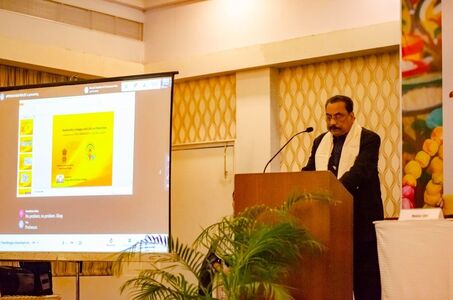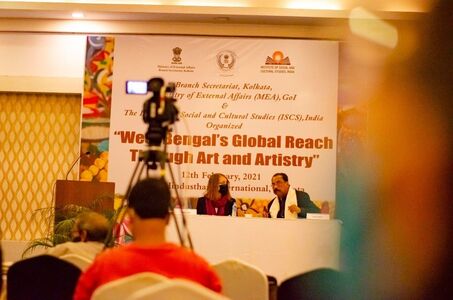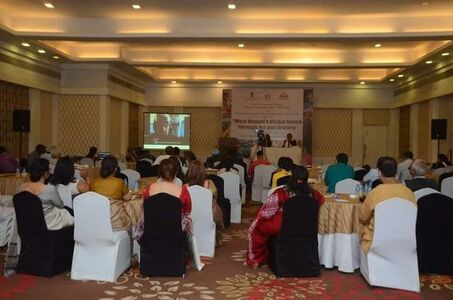India has always been a land of diversity. It has always welcomed various cultures and traditions. It is a country which has mixed its rich cultural diversity with the economy and markets. In India, the industry means more than just work, they are an expression of a particular community, ethnicity, or tradition, employing local craftsmanship and locally sourced materials. The handicraft industry is one of such industries.
India played an important role in the Silk Route. Silk Road was a network of trade routes which connected the East and West. The Silk Route derives its name from the lucrative trade in silk carried out along its length, beginning in the Han dynasty in China (207 BCE–220 CE). Silk Route in India are places that were important for trade of silk. There are 12 such places in India. Bihar, Jammu and Kashmir, Maharashtra, Puducherry, Punjab, Tamil Nadu and Uttar Pradesh.
Many of the Indian traditional crafts flourished as a result of noble patronage. During the Gupta Period of Indian History (mid-3rd century-5th century), crafts were highly in demand even outside the country. In India before the British, community participation existed in Handicraft, a system more inclusive but similar to what is called the ‘jajmani’ system which promoted cluster development for skill training, quality improvement and policy support. Jajmani system was reciprocal social and economic within a village community, by which one family exclusively performs certain services for the other in return for pay, protection, and employment security.
However, the glory of the Indian handicrafts industry came to the end by the mid-19th century. This was attributed to the ‘Discriminatory Tariff Policy’, wherein heavy duties were charged on Indian goods entering Britain, India’s colonial masters, while English goods to India were charged nominal duties. This price discrimination, coupled with the growing popularity of machine-made goods was the last nail in the coffin.
The Calcutta International Exhibition world's fair was held in Calcutta from the end of 1883 to March 1884 to promote Indian Handicrafts. It took place in the grounds of the Indian Museum and the Maidan opposite. The Maidan side of the fair was connected to the Indian Museum by a bridge across the Chowinghee Road. The success of the exhibition in Calcutta promoted The Colonial and Indian Exhibition of 1886 held in South Kensington in London, and intended to stimulate commerce. The exhibition was opened by Queen Victoria, and when it closed had received 5.5 million visitors. Handicrafts from different areas were split into different section representing the different princely states.
There were influences of British, French Dutch in the narratives of Handicrafts in Bengal. The British gained control of Bengal with a Royal Charter after the decisive overthrow of the Nawab of Bengal in 1757. In the 18th century during the British reign, oil and easel influenced the locals to take up water colour painting. The merchants of the East India Company provided a large market for native art in the 18th century, and a distinct genre of watercolour painting referred to as the Company style flourished at first in Murshidabad and spread to other cities of British India. The Dutch settled in Bengal 1627 in Chinsurah. Dutch influence in craft particularly Playing Cards, which were hand painted in Dutch Style. They also influenced the naming of the playing cards. Four names of the Suits are from Dutch : Ruhiton, Haroton, Inskhapon which corresponds to Ruiten, Harten, Shoppen. Which are Dutch names of Diamond, Heart and Spade. The exception is the suit of clubs which is Chiraton in Bengali and Klaveren in Dutch for clover.
The French settled in Chandannagar in 1673. The contribution of the French was Hand Crafted Book Binding particularly the introduction of the symbol fleur-de-lis. French miniature artist Jean-Jacques Belnos also introduced lithographic printing in India in 1822, Belnos set up a studio in 1847 in Calcutta paving way for Litho Printing.
After India’s Independence in 1947, the emphasis was laid on heavy industries so as to tap the country’s manufacturing potential. Not that Handicrafts were neglected and efforts were made to restore the lost legacy of Indian handicrafts, especially since the Khadi Movement was connected to our Independence and the father of the nation, Mahatma Gandhi as part of India’s freedom struggle.
Famous Handicrafts from Bengal. South and North 24 Parganas Clay doll, cotton doll and dolls made of cloth Howrah Jute crafts, Silver filigree, Embroidery Purulia Chhou mask and Dokra East Midnapur Clay doll, Mat, Conch–Shell West Midnapur Mat, Horn, Fold painting (Patachitra) Hooghly Chikon embroidery Nadia Clay dolls and Terracotta Birbhum Leather goods, Dokra and Kantha stitch Burdwan Dokra, Sola craft,Wooden doll andKantha Stitch Famous Handicrafts from Bengal Bankura Terracotta, Stone curving, Dokra, Wood Carving Murshidabad Jute doll and Handicrafts, Brass and BellMetal Malda Wooden Mask, Brass and Bell Metal Uttar Dinajpur Terracotta, Bamboo made Handicraft,Cane work DakshinDinajpur Dokra, Cane work and Bamboo made Handicraft Coochbehar Sitalpati Jalpaiguri Cane work, Bamboo Crafts Darjeeling Woollen hill-crafts and Painted masks.
One of the most important issue that this Seminar wants to highlight is the tracking the sustainability issues of these crafts at the global market and addressing the managerial challenges of the craft sector of West Bengal. To acquaint people having a passion for hand make work with a century old traditions, productive techniques being passed seamlessly by one generation to another.
The first aspect, I would like to recommend is Education. We need an all-round of craft education to make it popular.
The second is the Deconstruction of the Art Form. Not Reconstruction. But Deconstruction as in the philosophy of Jacques Derrida. Derrida had a direct impact on Design. Deconstruction places the emphasis on appearance and suggests that essence is maintained to be found in appearance. Deconstruction, form of philosophical and literary analysis, derived mainly from work begun in the 1960s by the French philosopher Jacques Derrida that questions the fundamental conceptual distinctions, or oppositions.
The third aspect I would like to touch is Marketing. Creation of a Brand. West Bengal handicrafts are one of the most preferred souvenirs carried widely by European tourists. Intricate form of metal craft, merchandise, earthenware taken back by tourists and non-residential Indians not only blooms the essence of rural Bengal in western household but builds a cultural viaduct between continents across.
While the institutional structure was apt, the vision was misleading. These institutions focused on promoting the handicrafts, without really improving the productivity of artisans through various incentive models. As a result, the exports grew, however, not up to their full potential. The handicrafts industry is largely cottage-based, predominantly located in villages and small towns. The success of any industry depends on the strength of its forward and backward linkages. For the handicraft industry, the diseconomies of scale occur in two forms: (i) high cost of access to markets for raw material (poor backward linkage), and (ii) high cost of access to output market (poor forward linkage). As a result, if the artisans wish to continue, they have to rely on middlemen, who charge higher prices. In the handicrafts industry, the local artisans often get a much lower remuneration due to inaccessibility to the highest paying market. For example, jute handicrafts are gaining popularity in the cities (especially after plastic bans).
However, an artisan producing Jute products in Murshidabad, West Bengal would not be able to take advantage of this due to lack of perfect information. Cultural Entrepreneurship entails creating organisations of arts, by and for artists that are financially sustainable and viable and have a cultural and societal impact. This would enrich the artist’s work by providing support and services and generate more opportunities for collaboration and cooperation.
Handicraft plays a significant role in familiarizing the country’s tourism resources also engaging the sightseers to build a convergence with cultural diversities, beliefs and practices with the inhabitants through handicrafts-their ancestral forms and contemporary framework in depth. Naya Gram is a big example: more than just a village in West Bengal’s Paschim Midnapore district. Naya is home to around 250 patuas or chitrakaars, a unique community of folk artistes who are painters, lyricists, singers and performers all rolled into one. Nayagram village is located in Midnapore Tehsil of Paschim Medinipur.
An important point is to safeguard the intangible cultural heritage of West Bengal. Hence resuscitating and revitalizing States linkages. West Bengal Handicrafts Development Corporation, a Government of West Bengal enterprise is principally into the promoting & marketing of the handicrafts and handloom products of the artisans of West Bengal through its MANJUSHA showrooms. In its strong pledge to aloft the traditional heritage of around 5 lakh exceptional artisan community of the state. Initiatives has been fermented to foster the growth and making the voices of artists be heard in various countries and sharing its crafts from its rich cultural tradition. The success story of the Fab India gives us an example of how branding can help an industry survive. Product differentiation did not just save it from extinction, but also elevated it to an art form.
The Indian handicrafts industry has failed to carve a niche in the international market as it has failed to effectively utilise branding and marketing techniques. The Government of India has added value to handicrafts that are been displayed at various craft and convention centres worldwide today. Currently, the Indian government is focusing on the skills training of rural artisans under the Deen Dayal Upadhyaya Grameen Kaushalya Yojna, a policy for rural empowerment. Handicraft sector in India not only had a rich and traditional offering for the world but through its array of different training have enhanced the quality of the handicrafts in the world’s economic forum. Designers from the National Institute of Design (NID) and National Institute of Fashion Technology (NIFT) have developed courses to upskill Self-Help Groups (SHGs) and individual artisans. Soft skills training programmes in export marketing, packaging and technology are being organised.
If we wish to keep up a high price, a high supply has to be matched by high demand. In order to increase the demand, dissemination of information to potential buyers is the key. This can be achieved through better marketing techniques in print and electronic media. E-Commerce and the Internet have opened new opportunities for the handicraft industry. The online market has helped local artisans meet their prospective buyers, eliminating the need for middlemen.
Government initiatives such as BharatNet for improving internet connectivity in rural areas would have socio-economic impacts for the sector. The Doha Round negotiation of the WTO, in 2005, mandated the removal of quotas for at least 97% of goods from the least-developed countries. Post the negotiation, the Indian handicraft export was expected to improve. And the exports did rise from 155,876 to 170,000 in 2006. But in 2008-09, the exports fell to 80,000 as a result of a global meltdown. 2019-20 ₹25270In 2016-17, exports from the sector aggregated to Rs 24,500 crore. India’s share in the world handicraft market is an appalling 2%, as compared to the 17% market share of China. Top Most Demanded Indian Handicrafts Indian Home Decorative Handmade Sarees, other hand made products Furniture, home textiles and home ware Precious gems and jewelleries.
Indian Handicraft plays a significant role in familiarizing the country’s tourism resources also engaging the sightseers to build a convergence with cultural diversities, beliefs and practices with the inhabitants through handicrafts-their ancestral forms and contemporary framework in depth. Indian handicrafts could be broadly divided into three categories: folk crafts, religious crafts and commercial crafts. Popular folk crafts that are modified according to the demands of the market become commercial crafts. Myriads of handicrafts are made for the diverse rites and rituals associated with the religious faiths of the varied ethnic groups of India. Creation of a platform for marketing/endorsements of a burgeoning scope of entrepreneurship of these crafts at International market. Social, economic and technological interventions can help the handicraft industry reach a place in the international market, a place that is rightfully deserve.
The Incredible India Campaign by the Ministry of External Affairs is the biggest example. The range of Indian Handicraft is as diverse as the culture diversity of the country. They embody our heritage of creativity, aesthetics and craftsmanship. At a more substantial level the Handicraft tradition has sustained generation of people in our country. As a highly decentralized activity the Handicraft industry is a shining example of Linkage and Cultural Diversity. We need to build one brand. India is home to 6.8 million artisans, but local artisans and traditional craftsmen have failed to crack into the international market. The exports have been controlled by already flourishing designers and a handful of master weavers.
Incredible India Namaskar !




